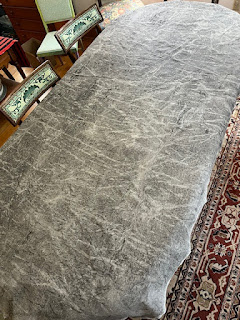It's been almost a year since my friend Sheryl came to Galesburg to help me color a large piece of linen with earth pigments, for one of the pieces about menhirs (neolithic standing stones) that I've been thinking about since a trip to Brittany in 2019. I've spent a lot of time reading, thinking, sketching, and doing trial stitching. My placeholder for a plan for the stitching was decided on back in August of last year, and appears at the end of this post. The idea for the plan was based on the actual alignments of stones at Carnac, thousands of stones laid out in parallel arrays, ten to thirteen lines of stones in each long array. I've kept close at hand the plan of the alignments below, where the tan expanses represent the lay-out of the lines of stones: 
But as I worked yesterday morning on another version last year's sketch, I decided to abandon it, and to just go to the fabric and start stitching, letting go of any notion of re-creating the layout of the alignments. Instead of following a plan, I will let myself go wherever I find the stitches taking me. I'll also have the marks in the fabric to follow or respond to, if I wish. This is because I've decided to stitch on the "back" side of the cloth Sheryl and I colored, rather than on the solid, brownish-black side that was my original intent. Sheryl had told me that many people end up using the back instead of the front, because of the beautiful, unplanned markings that show through on the back. After doing stitch trials on both the front and the back (on the right and left in the photo below), I've decided to switch, and stitch on the back side. The stitching will not be in as high a contrast to the fabric as I envisioned, but that's OK. The variations on the back, and stitching done in response to marking, is much more in keeping with the nature of the relationship of the neolithic stones to the terrain in which they were "planted," with lines of stones following variations in the terrain.

And here's stitching done yesterday and today on the full piece of cloth, about two hours spent in total.

Here's the full piece of cloth, draped on my dining room table, which is where I'll work on the stitching.
The next photo shows the fabric in the 12" hoop I'm using. The white cloth with a circle cut in it is a way to prevent the hoop from leaving a mark on the cloth. I'm also using a steam iron after each session of stitching, to iron out the indentation left by the hoop.

And here's a close-up of the stitching, which gives a good view of the actual coloration of the cloth, and also of the texture of the thread I'm using. It's a
silk-wrapped linen-paper thread from Habu Textiles. I love the variation in thickness of the thread, the stiffness of it (which leads to some variation in how the thread lays) and the occasional wispiness of the very thin silk thread that sometimes separates from the linen "paper" thread.
So, I have begun. The piece will take a very long time, which is intentional. It is one way to honor the persistence of the communities who
placed one stone after another, over many years, six thousand years ago. [Added 8-10-25: Here's a
link to a video that gives an aerial overview of the alignments in Brittany.







I absolutely love the back of the cloth. I don't know if you remember the vest I got married in, but I used the back of a printed patterned cloth rather than the front because I liked the way the bleed through of the pattern looked better than the more uniform pattern on the front.
ReplyDeleteOh I'm so glad you decided to use the back! And I think allowing the stitching to respond to the cloth and the variations in the color is a really inspired idea, though I imagine it was hard to let go of your original plan. So excited to see this moving forward!
ReplyDeleteAgain, Penny, your patience is to be admired. The stitching is beautiful and the process will bring forth a meaningful creation.
ReplyDeleteWow. This is very un-Penny like...just going with the flow instead of a well thought out plan. Letting go of outcomes is a great way to relinquish control and live in the minutes. Just loving this Penny!!!!
ReplyDelete